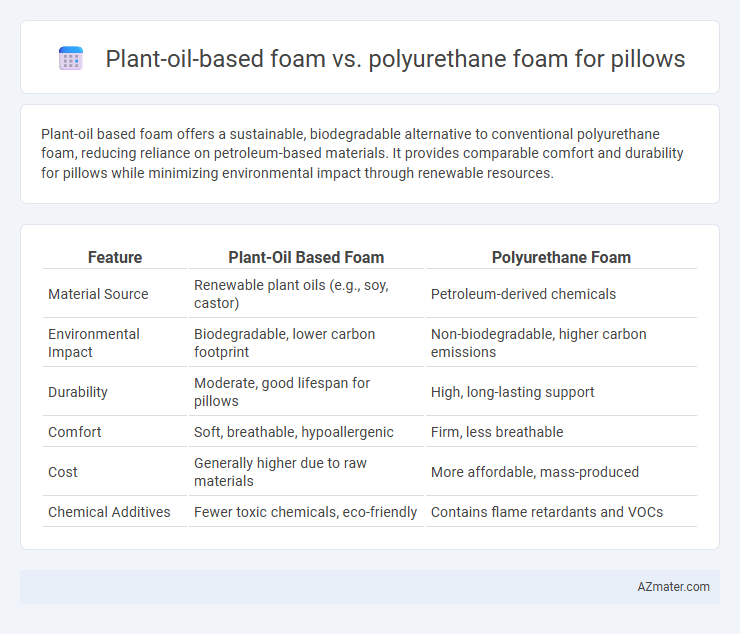Plant-oil based foam offers a sustainable, biodegradable alternative to conventional polyurethane foam, reducing reliance on petroleum-based materials. It provides comparable comfort and durability for pillows while minimizing environmental impact through renewable resources.
Table of Comparison
| Feature | Plant-Oil Based Foam | Polyurethane Foam |
|---|---|---|
| Material Source | Renewable plant oils (e.g., soy, castor) | Petroleum-derived chemicals |
| Environmental Impact | Biodegradable, lower carbon footprint | Non-biodegradable, higher carbon emissions |
| Durability | Moderate, good lifespan for pillows | High, long-lasting support |
| Comfort | Soft, breathable, hypoallergenic | Firm, less breathable |
| Cost | Generally higher due to raw materials | More affordable, mass-produced |
| Chemical Additives | Fewer toxic chemicals, eco-friendly | Contains flame retardants and VOCs |
Introduction to Foam Materials in Pillows
Plant-oil based foam and polyurethane foam are two common materials used in pillow manufacturing, each offering distinct properties for comfort and support. Plant-oil based foams utilize renewable resources like soy or castor oil, enhancing sustainability and reducing reliance on petroleum, whereas polyurethane foam is a petroleum-derived product known for its durability and versatility in cushioning. Both foams provide varying degrees of resilience, breathability, and contouring ability, impacting pillow performance and user experience.
What is Plant-Oil Based Foam?
Plant-oil based foam is a sustainable alternative to traditional polyurethane foam, primarily derived from renewable plant oils such as soy or castor oil. It offers comparable comfort and support for pillows while reducing reliance on petroleum-based materials and lowering environmental impact. This eco-friendly foam type is increasingly favored in bedding products for its hypoallergenic properties and biodegradability.
Understanding Polyurethane Foam
Polyurethane foam, widely used in pillows, is a versatile polymer derived from petrochemicals offering excellent durability, resilience, and support. Its cellular structure provides breathability and pressure relief, making it a popular choice for ergonomic comfort in bedding products. Innovations in plant-oil based alternatives seek to reduce environmental impact while maintaining the mechanical properties that define traditional polyurethane foam.
Manufacturing Processes Compared
Plant-oil based foam for pillows is produced through bio-polymerization, utilizing renewable resources such as soy or castor oil, which reduces reliance on petroleum and lowers carbon emissions during manufacturing. Polyurethane foam manufacturing involves chemical reactions between polyols and isocyanates derived from petrochemicals, often resulting in higher energy consumption and volatile organic compound (VOC) emissions. Compared to polyurethane, plant-oil based foam offers a more sustainable production process with improved biodegradability and reduced environmental impact.
Comfort and Support: A Performance Analysis
Plant-oil based foam pillows offer superior breathability and natural temperature regulation, enhancing overall comfort during sleep. Polyurethane foam provides denser support, evenly distributing body weight to maintain proper spinal alignment. The balance of resilience in plant-oil foam versus the durability of polyurethane foam determines optimal performance for diverse sleep preferences.
Sustainability and Environmental Impact
Plant-oil based foam for pillows significantly reduces reliance on petroleum, lowering carbon emissions and promoting renewable resource use compared to traditional polyurethane foam. This bio-based foam is often biodegradable and produces fewer toxic byproducts during manufacturing and disposal, enhancing environmental safety. In contrast, polyurethane foam typically involves non-renewable petrochemicals, emits volatile organic compounds (VOCs), and presents challenges in recycling and landfill degradation.
Health and Safety Considerations
Plant-oil based foam pillows offer enhanced breathability and reduced exposure to harmful volatile organic compounds (VOCs) compared to traditional polyurethane foam, promoting better indoor air quality and reducing allergy risks. The natural origin of plant-based foams often results in hypoallergenic and antimicrobial properties, making them safer options for sensitive skin and respiratory conditions. Polyurethane foam, while durable, may release toxic chemicals like isocyanates and flame retardants, raising health concerns during prolonged use or improper ventilation.
Longevity and Durability
Plant-oil based foam pillows demonstrate enhanced longevity due to their natural resilience and resistance to compression over time, maintaining shape and support longer than traditional polyurethane foam. Polyurethane foam often degrades faster with repeated use, resulting in quicker flattening and loss of durability. The bio-based components in plant-oil foams contribute to higher durability by reducing the rate of material breakdown compared to synthetic polyurethane options.
Cost Comparison
Plant-oil based foam pillows generally cost 15-25% more than traditional polyurethane foam due to sustainable raw materials and eco-friendly processing. The higher initial investment is offset by increasing consumer demand for environmentally responsible products, driving economies of scale and potential long-term savings. Polyurethane foam remains more affordable in mass production, but fluctuating petroleum prices can impact costs, making plant-oil foam a competitive alternative in pricing over time.
Choosing the Right Foam for Your Pillow
Plant-oil based foam offers enhanced breathability and environmental benefits, making it ideal for eco-conscious pillow users seeking natural materials. Polyurethane foam provides superior support and durability, offering excellent shape retention for those prioritizing firmness and longevity. Choosing the right foam depends on preferences for sustainability versus performance, with plant-oil foams excelling in comfort and airflow, while polyurethane foams deliver consistent support.

Infographic: Plant-oil based foam vs Polyurethane foam for Pillow
 azmater.com
azmater.com